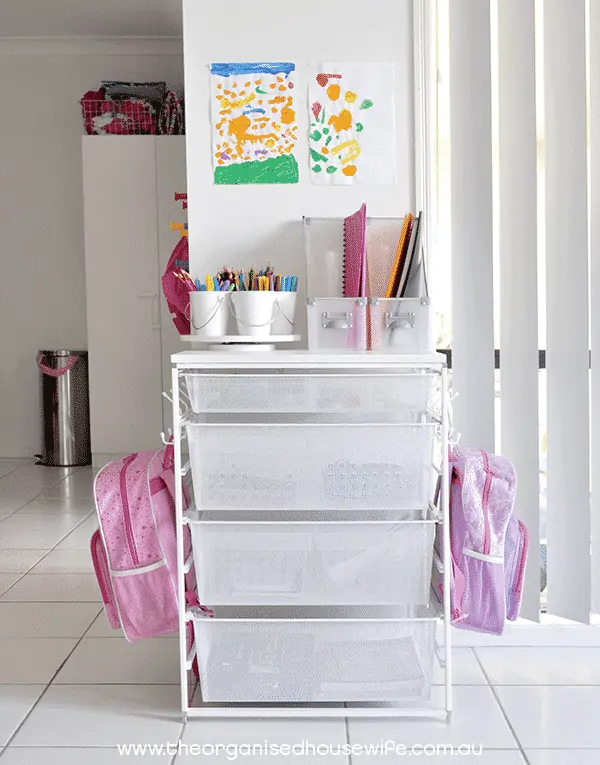Starting off the day doesn’t have to be a flurry of chugging coffee while you pull out a textbook for your child to read. A homeschool schedule just may be your saving grace for getting order restored to a house full of kids who need structure in their daily routine. Otherwise, you may find that there just aren’t enough hours in the day to cover everything from geography to what’s for dessert. Let’s take a look at how to make a homeschooling schedule that works best for you AND your kids!

Create a Homeschool Schedule that Works for your Family
When designing your own curriculum and schedule, it can quickly get overwhelming. You may have no idea where to start!
I 100% understand and relate to this. I was also in this position… But, now that we have a set routine and homeschool schedule, my kids are much happier (and so am I).
Now, it’s your turn!
In today’s post, I’ll be sharing a helpful guide that outlines some tips and hacks on how you can create your own homeschool daily schedule that works for everyone in your house.
Building A Routine vs. A Schedule
When you hear the word “schedule”, chances are you are thinking about something that looks like this:
8:00 – wake up, brush teeth, get dressed
9:00 – eat breakfast
9:30 – morning reading
And so on and so on.
Now, some call it a routine while others call it a schedule, but there is actually a difference.
A schedule indicates set times to complete specific activities. As a parent, this isn’t always realistic to assume that everyone can stay on top of time. Usually, it creates unnecessary stress as you worry about finishing an activity on time, so you don’t get behind.
A routine, however, is a list of tasks for the day and perhaps an order in which you will do them. The routine bundle is a great place to get started!
Today’s post will talk about both terms interchangeably, but just know that whichever works best for your organization-style is quite alright.
Both methods help establish a structure for homeschooling and should be part of the everyday life of a kid.
How To Create A Homeschool Schedule
Here are a few tips to help you get started…
1. Start Off With Long Term Goals
Before you get started looking at what day-to-day life as a homeschooling parent will be, you need to look at the big picture. What needs to be accomplished in the year?
Your state may have homeschooling laws that will determine not only your curriculum but what days off you’ll have too.
Once you have the overarching plan in place, you can break down goals into semesters, months, or whatever you wish. Flexibility means you get to decide how things will go in the grand scheme!
Starting off with the big picture makes planning that much more digestible. When you have a monthly plan, you have a weekly plan, followed by a daily plan.
Everything feels attainable when you think of it this way.
2. Find A Start Time
Kids aged 5 to 12 need 9 to 12 hours of sleep every night.
Doesn’t that sound like a dream? One of the best things about homeschooling is that morning doesn’t have to feel nearly as rushed.
Without needing to commute to school, you get nearly an extra hour in the morning. And, if your kids don’t have a good night’s sleep, you can even let them sleep in a bit to avoid any cranky behavior.
As mentioned above, you don’t have to have a set time – it’s more the idea of creating a routine.
- Do your kids start their day after having breakfast?
- Going for a morning walk?
- Finishing up a daily chore?
Having an anchor to start the day will help create consistency in your child’s school day.
This also doesn’t even have to be morning. When does your kid focus best? Like adults, some kids just aren’t early birds. Perhaps they are better off to start the studious part of the day in the afternoon when their attention span is better.
Creating a list of everything that needs to be done in the morning before the kids officially start the day can be beneficial for both of you. Then, you’re ready to kick off the school day.
3. What Time Works Best For YOU?
You are the other big half of this equation. While the kids certainly come first, your needs are also at play here.
Ask yourself, what timelines are realistic for you? This can mean:
- Start times
- Days of the week for studying
- Timelines for the day
After all, trying to juggle work while homeschooling and taking care of the house is a whole article in itself.
For instance, parents with irregular working schedules may want to have their kids on a similar schedule. Weekends don’t have to be Saturday and Sunday!
4. Set A Realistic Homeschool Schedule
One of the joys of homeschooling is that the kids don’t have to sit down and be in a classroom from 8 to 3 every day. Realistically, kids get much more one-on-one time and fewer breaks throughout the day.
Actual time spent on working on assignments and learning can drastically be cut down compared to a “regular” school day. This is probably the biggest difference between homeschool vs. traditional school.
When creating a lesson plan for the day, ask what tasks need to be completed? This includes more than just studies. It can also mean chores, free time, sports, playing, etc.
You also want to decide how to layout subjects. Unlike attending a traditional school, your child doesn’t need to tackle each subject every day. A block schedule is when one or two subjects are worked on per day rather than every subject for an hour every day.
A loop schedule is when you create a list of activities to do but set no specific timeline. Think of it as a to-do list! You can even do both, choosing to add extra activities as a loop schedule.
Also, consider what activities can be combined in a day to save time. For example, if you are teaching two different ages, can they study the same subjects at the same time on similar topics?
5. Establish Hobby Time
Not all kids want to study the periodic table, and others could bury themselves in nothing but book after book. Every child has their own passion and hobbies that they should explore.
With all the extra free time that comes with homeschooling, it’s time to dedicate that to what they love best.
This can mean time for crafting, free play, time spent outside in nature, or even an opportunity for socializing for all those teenagers out there.
6. Set Boundaries
While there is certainly a lot of flexibility when it comes to homeschooling, establishing boundaries helps to keep a degree of structure and expectations for the child.
This will look different for each household and learning style.
For example, you may want no screens, no electronics, a specific area you’ve designated for schooling, or no unplanned breaks. This will also help to distinguish the time spent between “school” and “home” as part of their routine.
7. Leave Space Throughout The Day
If there’s one thing we know for sure as parents, things never go as planned. Even if you schedule everything to the minute and run a tight ship, some activities will take longer than expected, whether due to the frustration of solving a math problem or the enjoyment of painting a picture.
Allowing scheduled breaks and extra time between activities ensures that you can somewhat prepare for those unexpected moments.
8. Plan Your Homeschool Schedule Ahead Of Time
Last on this list of homeschool schedule ideas, you have what may arguably be the most important…planning for the week ahead. Planning out your lessons in advance makes things go that much more smoothly.
Try to set a time during the weekend to plan out the school week ahead. Make sure to include all the days’ activities such as:
- Dinner plans
- Sports games
- Music lessons
- And, everything in between the best you can.
This will help ensure you get everything done for the week but also helps you to find the right amount of balance. You can leave enough time for the family to be together, the kids to have their own playtime, and for you to have a quiet moment to yourself.
Wouldn’t that be lovely?
Plan everything out so that you can prioritize certain activities. This way, you don’t have to beat yourself up if not everything gets done.
Having a map for the week ahead will also allow the kids to know what to expect and prepare for the week ahead themselves. In fact, letting your kids help to make the schedule can be a great activity to ensure you both are happy with what’s planned for the week.
The Takeaway
While you can spend hours crafting the perfect homeschool schedule outline, always remember that routine is constantly changing. What works this month may not work the next.
One minute your kid loves the idea of learning all about frogs, the next month, they want to sit inside and learn guitar. Life with kids just wouldn’t be fun if it were predictable!
Some degree of structure is important, but that will look different for every family. It all comes down to the child’s learning style to create a routine that works for everyone.
Remember that practice makes perfect. Setting up a homeschool schedule takes time to become second nature. After all, they say it takes 66 days for something to become a habit!
More Homeschool Inspiration
- 11 Disadvantages of Homeschooling to Consider
- What’s the Difference Between Remote Learning & Homeschool?
- 15 Inspiring Homeschool Room Ideas for Small Spaces
- Pros and Cons of Homeschool & How Do You Homeschool?
- How To Identify Your Children’s Reading Levels + Which Books to Read
- 11 Helpful Charts for Kids: Chores, Reward & Daily Routines to Help Kids Thrive
- Create a Routine: 6 Sample Toddler Schedules from Real Moms
Want even more?
Shop All Parenting Resources
Shop all of our parenting resources from self-regulation tools and managing big emotions to building self esteem and confidence. There are resources for all seasons of life!









